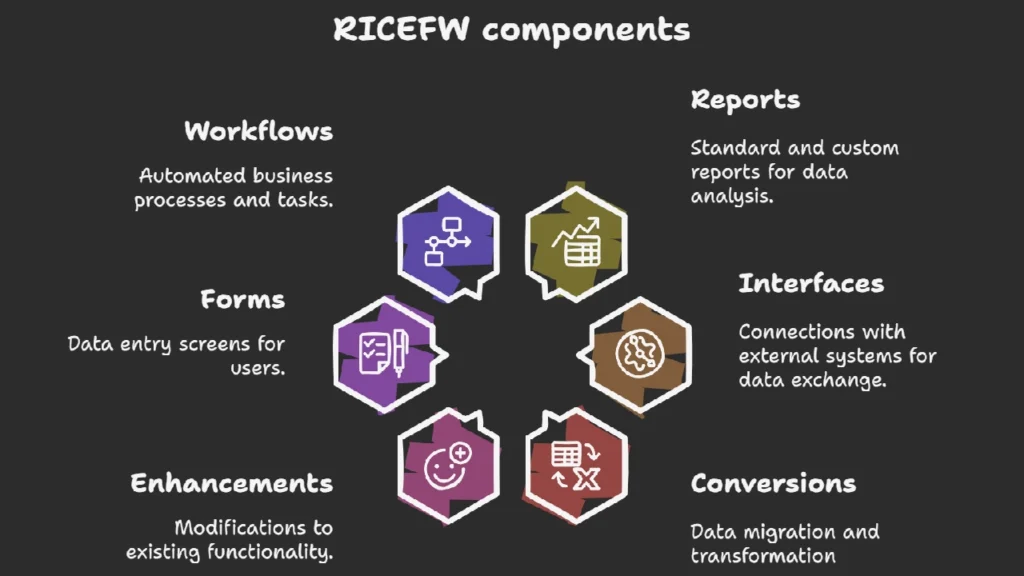If you’re diving into the world of SAP implementations, the term RICEFW in SAP will pop up again and again. It’s not just an acronym—it’s the heart of customizing SAP to suit unique business needs.
Let’s break it down and understand what RICEFW really means, why it matters, and how it fits into your SAP journey.

What is RICEFW in SAP?
RICEFW in SAP is a six-letter acronym used during SAP implementation or upgrade projects. It stands for:
- R – Reports
- I – Interfaces
- C – Conversions
- E – Enhancements
- F – Forms
- W – Workflows
These elements are essential when the standard SAP system doesn’t completely fulfill a company’s specific requirements. Each part of RICEFW plays a role in ensuring the final SAP solution is tailored, efficient, and business ready.
1 Reports: Turning Data into Insights
Standard SAP comes with many reports, but they don’t always match what your business needs. That’s where custom reports come in. These are designed to fetch, calculate, and present data in a way that helps teams make smart decisions.
For example, a business might need a custom report to track vendor delivery performance over time. Developers build it using ABAP (SAP’s programming language) or tools like SAP Query and SAP Analytics Cloud.
2 Interfaces: Connecting SAP with the Outside World
No system works alone. Most businesses use multiple applications—like Salesforce, banking systems, or logistics tools. Interfaces help SAP talk to these systems by sharing data between them.
These can be real-time (using APIs, IDocs, or RFCs) or batch-based (like file transfers). A well-built interface ensures smooth integration, real-time updates, and fewer manual errors.
3 Conversions: Migrating Legacy Data
When a company moves from an old system to SAP, data migration is critical. Conversions are all about transforming data—like customer records, inventory, or financial history—into SAP-compatible formats.
This process ensures that no data is lost and everything fits into SAP’s structure. Tools like LSMW, BDC, and SAP Data Services are commonly used for this.
4 Enhancements: Extending Standard SAP
Even though SAP is powerful, sometimes businesses want extra fields, new screens, or changed behaviors. Enhancements allow you to tweak standard SAP without disrupting the core system.
You can use User Exits, BAdIs, Enhancement Points, or the newer In-App Extensibility in SAP S/4HANA. This lets you align SAP with your unique workflows.
5 Forms: Custom Business Documents
Think about invoices, purchase orders, or shipping labels. These need to look professional and match your company’s format. Forms allow SAP to generate print-ready documents with logos, specific fields, and formatting.
Technologies like SAP Smart Forms, Adobe Forms, and SAPscript help design these outputs, tailored for printing or emailing.
6 Workflows: Automating Business Processes
SAP Workflows ensure tasks move smoothly between departments. For instance, a purchase request might go from a buyer to a manager for approval, then to finance.
Workflows in SAP define who does what, when, and under what conditions. With automation, you save time, reduce errors, and increase visibility.
Why is RICEFW Important?
RICEFW in SAP acts like a project checklist for SAP consultants and developers. It helps:
- Scope the work correctly
- Assign the right technical teams
- Plan the development effort
- Track progress and testing
- Ensure nothing is missed before go-live
Each RICEFW object usually comes with documentation, approval processes, and testing cycles before it’s moved into the live system.
Real-World Example
Imagine a retail company implementing SAP S/4HANA:
- They need a custom Sales Performance Report → Report
- Integration with their online store → Interface
- Customer master data from the old ERP → Conversion
- A special discount logic in billing → Enhancement
- A branded invoice layout → Form
- An approval chain for bulk discounts → Workflow
All these falls under the RICEFW framework.
Final Thoughts
RICEFW is more than an acronym—it’s the foundation for tailoring SAP to your business. Whether it’s through reports, automation, or data migration, each component plays a crucial role in delivering a complete, functional SAP solution.
For anyone involved in SAP—be it consultants, developers, or clients—understanding RICEFW is key to managing expectations, timelines, and successful project delivery.







